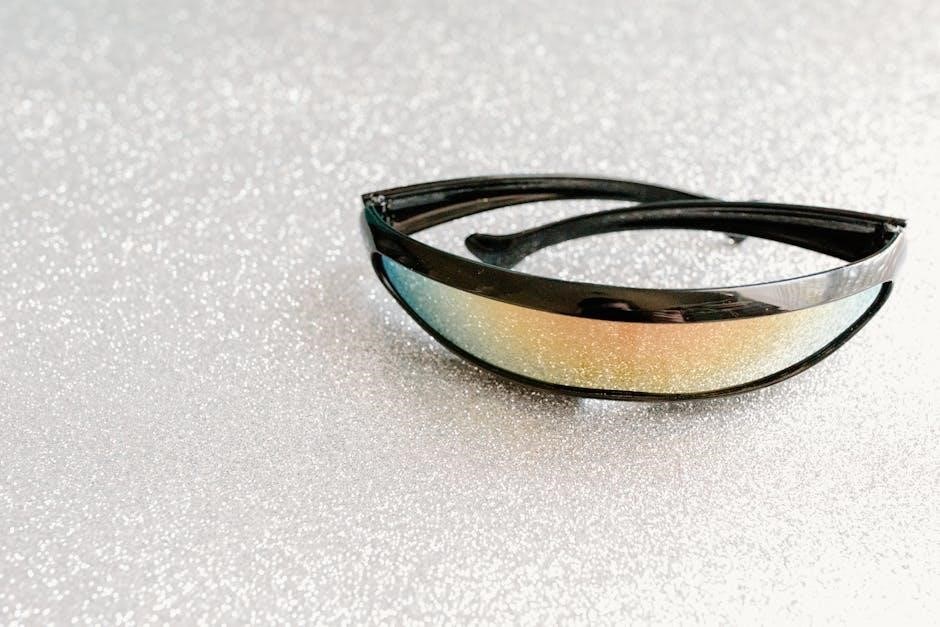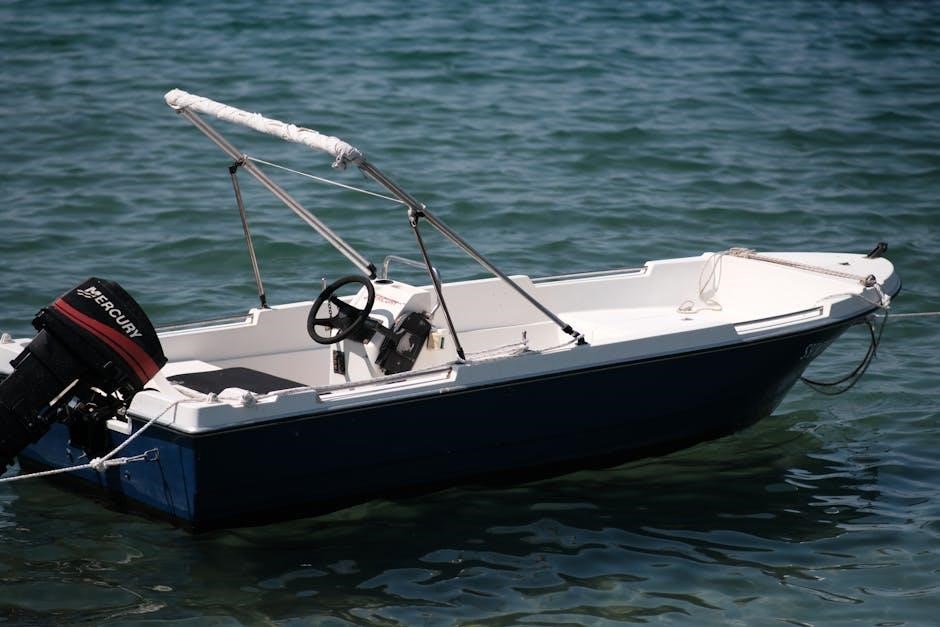Mercury outboard beep codes are diagnostic tools indicating engine issues. Understanding these codes is crucial for maintaining boat safety and performance‚ as they signal potential problems ranging from sensor malfunctions to electrical issues. Referencing a Mercury outboard beep codes PDF guide provides detailed insights and solutions‚ ensuring timely repairs and preventing further damage.
1.1 Overview of Mercury Outboard Motors

Mercury outboard motors are renowned for their reliability‚ performance‚ and innovation in the marine industry. Available in a wide range of horsepower‚ from compact portable engines to high-performance V6 and V8 models‚ these motors cater to diverse boating needs. Known for their advanced technology‚ Mercury outboards feature fuel injection systems‚ digital controls‚ and integrated sensors for optimal efficiency and control. They are widely used in recreational‚ commercial‚ and competitive fishing applications‚ offering durability and low emissions. The motors are designed to meet stringent environmental standards while delivering exceptional power and responsiveness. Their robust construction ensures long-term reliability in various marine conditions. Mercury’s commitment to innovation has made their outboards a preferred choice for boaters worldwide. The diagnostic systems‚ including beep codes‚ are integral to their maintenance and repair processes.
1.2 Importance of Understanding Beep Codes
Understanding Mercury outboard beep codes is essential for identifying and addressing engine issues promptly. Beep codes serve as diagnostic tools‚ signaling potential problems such as sensor malfunctions‚ low oil pressure‚ or electrical faults. By recognizing these codes‚ boat operators can take immediate action‚ preventing minor issues from escalating into major repairs. Ignoring or misinterpreting these alerts may lead to engine damage‚ safety hazards‚ or operational downtime. Familiarity with these codes enhances maintenance efficiency‚ reduces costs‚ and ensures safer boating experiences. Referencing a Mercury outboard beep codes PDF guide provides clear explanations‚ enabling users to diagnose and resolve problems effectively‚ thus maintaining optimal engine performance and longevity.

Common Mercury Outboard Beep Codes
Mercury outboard beep codes indicate various engine issues‚ such as sensor malfunctions or electrical problems. The number of beeps corresponds to specific diagnostic trouble codes‚ aiding in quick identification and resolution. Referencing a Mercury outboard beep codes PDF guide ensures accurate troubleshooting and repair‚ minimizing downtime and ensuring optimal engine performance.
2.1 Single Beep Codes and Their Meanings
A single beep code on a Mercury outboard motor typically indicates a low oil pressure warning. This alert system is designed to notify operators of potential engine issues early‚ preventing severe damage. The single beep suggests that the oil pressure has dropped below a safe threshold‚ which could be due to insufficient oil levels‚ a faulty oil pump‚ or a clogged oil filter. It’s essential to address this immediately by checking the oil level and inspecting related components. Ignoring this warning can lead to engine damage‚ increased repair costs‚ and safety risks while operating the vessel. Always consult the Mercury outboard beep codes PDF guide for precise diagnostic steps and solutions.
2.2 Double Beep Codes and Their Implications
A double beep code on a Mercury outboard motor signals an over-voltage or under-voltage condition in the electrical system. This typically occurs when the battery voltage exceeds or drops below the acceptable range‚ often due to a faulty alternator‚ corroded battery terminals‚ or wiring issues. Prolonged exposure to incorrect voltage levels can damage sensitive electrical components‚ including the engine control module. It’s crucial to inspect the battery‚ alternator‚ and wiring connections immediately. Consulting the Mercury outboard beep codes PDF guide will provide specific diagnostic steps and repair recommendations. Addressing this issue promptly ensures the longevity of your outboard motor and prevents costly repairs down the line.
2.3 Triple Beep Codes: What They Indicate
A triple beep code on a Mercury outboard motor typically indicates a low oil pressure warning. This is often triggered by insufficient oil levels‚ a faulty oil pressure sensor‚ or blockages in the oil system. Ignoring this alert can lead to serious engine damage‚ as proper lubrication is critical for maintaining engine health. It’s essential to immediately shut off the engine and check the oil level‚ ensuring it meets the manufacturer’s specifications. Additionally‚ inspect the oil pressure sensor and connections for any defects or corrosion. Consulting the Mercury outboard beep codes PDF guide will provide detailed troubleshooting steps and repair procedures to resolve this issue effectively and prevent potential engine failure.
2.4 Four Beep Codes: Common Issues
A four-beep code on a Mercury outboard motor often signals a problem with the engine’s electrical or sensor systems. Common issues include faulty wiring‚ corroded connections‚ or a malfunctioning engine control module (ECM). This code may also indicate a loss of communication between sensors and the ECM‚ which can disrupt critical engine functions. In some cases‚ it could point to a failed crankshaft or camshaft position sensor‚ which are vital for proper engine timing. To diagnose the issue‚ it’s essential to check all sensor connections and wiring for damage or corrosion. Using a multimeter to test electrical components can help identify the root cause. Referencing the Mercury outboard beep codes PDF guide will provide specific troubleshooting steps and repair recommendations to address this alert effectively.

Troubleshooting Mercury Outboard Beep Codes
Troubleshooting Mercury outboard beep codes involves identifying the source of the alert‚ checking sensor connections‚ and testing electrical components. Use diagnostic tools and the Mercury PDF guide for accurate repair solutions.
3.1 Identifying the Source of the Beep Code
Identifying the source of a Mercury outboard beep code requires careful analysis. Start by noting the sequence and frequency of the beeps‚ as these patterns correspond to specific issues outlined in the PDF guide. Common sources include faulty sensors‚ low fluid levels‚ or electrical malfunctions. Referencing the official Mercury documentation helps pinpoint the exact component causing the alert. Additionally‚ using diagnostic tools like multimeters can aid in verifying sensor readings and wiring integrity. By systematically eliminating potential causes‚ you can isolate the root of the problem and address it effectively‚ ensuring the engine operates smoothly and safely. Always consult the PDF guide for accurate troubleshooting steps.
3.2 Resetting the Alarm System
Resetting the alarm system on a Mercury outboard motor is a straightforward process once the underlying issue has been addressed. Depending on the model‚ this may involve pressing and holding a specific button or sequence of buttons on the control panel. Refer to the Mercury outboard beep codes PDF guide for precise instructions‚ as procedures can vary by engine model. After resolving the problem‚ restart the engine to ensure the alarm clears. If the alarm persists‚ consult the PDF guide for additional troubleshooting steps. Always verify that the system has reset properly before resuming operation. Regular maintenance and adherence to the guidelines in the PDF can help prevent recurring issues and keep your outboard running smoothly.
3.3 Checking Sensor Connections
Checking sensor connections is a critical step when troubleshooting Mercury outboard beep codes. Faulty or loose connections can trigger alarms‚ so ensure all sensors are securely plugged in and free from corrosion. Referencing the Mercury outboard beep codes PDF guide helps identify which sensors correspond to specific codes; Gently clean connectors with a soft cloth or electrical cleaner if necessary. After reconnecting‚ restart the engine to see if the alarm clears. If issues persist‚ the sensor itself may need replacement. Regular inspection of these connections‚ as outlined in the PDF‚ can prevent future problems and maintain optimal engine performance. Always follow the guide’s recommendations for proper maintenance and repair procedures.

3.4 Testing Electrical Components
Testing electrical components is essential when addressing Mercury outboard beep codes. Start by disconnecting the battery to ensure safety. Use a multimeter to check voltage‚ resistance‚ and continuity across wiring‚ sensors‚ and connectors. Look for signs of corrosion‚ wear‚ or damage‚ as these can cause faulty readings. Refer to the Mercury outboard beep codes PDF guide for specific testing procedures. Common issues include low battery voltage‚ faulty alternators‚ or malfunctioning sensors. If a component fails testing‚ replace it with a genuine Mercury part. After repairs‚ reconnect the battery and test the system to confirm the issue is resolved. Regular electrical testing‚ as outlined in the guide‚ helps prevent unexpected failures and ensures reliable engine operation. Always follow safety protocols when working with electrical systems to avoid further damage or injury.

Mercury Outboard Beep Code PDF Guide
The Mercury Outboard Beep Code PDF Guide is a comprehensive resource detailing diagnostic procedures‚ troubleshooting steps‚ and repair solutions for various beep code alerts. It is available online and serves as an essential tool for boat owners to identify and resolve engine issues efficiently.

4.1 Where to Find the Official PDF Document
The official Mercury Outboard Beep Code PDF document can be found on the Mercury Marine website or through authorized dealers. It is often included in the owner’s manual or available for download in the support section. Additionally‚ marine forums and trusted boating communities may share links to the guide. When searching online‚ use specific keywords like “Mercury Outboard Beep Codes PDF” or “Mercury Marine Diagnostic Guide” to locate the document quickly. Ensure the source is reliable to avoid incorrect or outdated information. Some websites may require registration or verification to access the PDF‚ but it is worth the effort for accurate troubleshooting.
4.2 How to Interpret the PDF Guide
The Mercury Outboard Beep Code PDF guide is structured to help users quickly identify and resolve issues. Start by locating the beep code section‚ which lists sequences and their corresponding fault descriptions. Codes are typically categorized by the number of beeps (e.g.‚ single‚ double‚ or triple) and their duration. Cross-reference the code with the provided explanations to understand the issue‚ such as sensor malfunctions or system errors. The guide often includes troubleshooting steps and recommended repairs. Pay attention to diagrams or tables that illustrate wiring or sensor locations. For complex issues‚ the PDF may suggest using diagnostic tools or consulting a professional. Always follow the guide’s instructions carefully to ensure accurate diagnoses and effective solutions.
4.3 Key Sections to Focus On
The Mercury Outboard Beep Code PDF guide contains essential sections that are vital for effective troubleshooting. Begin with the table of contents to navigate easily through the document. The beep code index is a critical section‚ listing all possible codes and their meanings. Pay attention to the fault code descriptions‚ which provide detailed explanations of each issue. Diagnostic procedures are another key area‚ offering step-by-step instructions for identifying and resolving problems. Additionally‚ the guide includes wiring diagrams and sensor location charts‚ which are invaluable for pinpointing electrical or mechanical faults. Finally‚ refer to the troubleshooting tips section for practical advice on common issues. By focusing on these sections‚ users can efficiently diagnose and address problems‚ ensuring optimal engine performance and reliability.

Maintenance Tips to Prevent Beep Code Alerts
Regular propeller inspection‚ cooling system checks‚ and ensuring proper fuel quality help prevent beep code alerts. Clean electrical connections and monitor battery health to avoid issues.
5.1 Regular Servicing and Inspections
Regular servicing and inspections are vital to prevent beep code alerts on Mercury outboards. Schedule annual professional maintenance to ensure all components are in optimal condition. During inspections‚ technicians check for worn or damaged parts‚ such as belts‚ hoses‚ and propellers‚ which could trigger alarms. Additionally‚ regular oil changes and filter replacements help maintain engine health. Inspecting electrical connections and sensors ensures they function correctly‚ preventing false or unnecessary alerts. By adhering to a consistent maintenance routine‚ boat owners can identify and address potential issues before they escalate‚ reducing the likelihood of encountering beep codes during operation.
5.2 Monitoring Fluid Levels and Filters
Monitoring fluid levels and filters is essential for preventing beep code alerts in Mercury outboards. Regularly check the engine oil‚ coolant‚ and hydraulic fluid levels to ensure they are within the recommended range. Low levels or contamination can trigger alarms‚ so it’s crucial to address these issues promptly. Additionally‚ inspect air and fuel filters for dirt or debris‚ as restricted airflow or fuel flow can cause malfunctions. Clean or replace filters as specified in the maintenance schedule. Neglecting these checks can lead to reduced performance‚ increased wear on components‚ and potential activation of diagnostic codes. Always refer to the Mercury outboard beep codes PDF for specific guidance on fluid and filter maintenance to keep your engine running smoothly and avoid unnecessary alerts.
5.3 Ensuring Proper Battery Maintenance
Proper battery maintenance is vital to prevent Mercury outboard beep code alerts related to electrical system issues. Regularly check the battery charge level and ensure terminals are clean and secure. For flooded batteries‚ maintain the correct electrolyte level‚ and avoid deep discharges. Use a multimeter to test voltage and ensure it meets specifications. Replace batteries showing signs of wear or age‚ as outdated or weak batteries can trigger alarms. Refer to the Mercury outboard beep codes PDF for specific voltage requirements and testing procedures. Neglecting battery health can lead to system malfunctions and unnecessary diagnostic codes‚ potentially causing operational disruptions. Consistent upkeep ensures reliable engine performance and minimizes the risk of electrical-related alerts.

Advanced Diagnostics for Beep Code Resolution
Advanced diagnostics involve using specialized tools and software to identify and resolve beep code issues‚ ensuring accurate and efficient troubleshooting as outlined in the PDF guide.
6.1 Using Diagnostic Tools and Software
Diagnostic tools and software are essential for accurately interpreting beep codes and resolving issues efficiently. A digital multimeter can measure voltage and resistance‚ helping identify faulty sensors or wiring. Mercury-specific scan tools‚ such as those compatible with VesselView‚ allow technicians to read detailed fault codes and monitor engine parameters in real time. Additionally‚ advanced software can analyze data logs to pinpoint the root cause of alerts. Regular updates to these tools ensure compatibility with the latest Mercury outboard models. By following the guidance in the PDF manual‚ users can effectively utilize these tools to diagnose and repair issues‚ minimizing downtime and ensuring optimal engine performance.
6.2 Consulting a Professional Mechanic
When encountering complex or persistent beep codes‚ consulting a certified Mercury outboard mechanic is advisable. These professionals have extensive experience and access to specialized tools and the latest PDF guides‚ ensuring accurate diagnostics and repairs. They can interpret codes‚ perform advanced testing‚ and address underlying issues that may not be apparent to boat owners. Regular maintenance by a mechanic can also prevent future problems‚ enhancing the longevity and reliability of the outboard motor. By leveraging their expertise‚ boat owners can avoid costly mistakes and ensure their vessel operates safely and efficiently‚ adhering to manufacturer recommendations outlined in the Mercury outboard beep codes PDF.

Case Studies and Real-Life Examples
Real-life examples highlight how Mercury outboard beep codes alert users to critical issues. For instance‚ a four-beep code on a 2007 Mercury 115 four-stroke indicated low oil pressure‚ resolved by checking sensor connections and ensuring proper electrical functioning‚ as detailed in the PDF guide.
7.1 Common Scenarios and Solutions
One common scenario involves a four-beep code on a 2007 Mercury 115 four-stroke engine‚ indicating low oil pressure. Users resolved this by checking sensor connections and ensuring proper electrical functioning. Another example is a triple beep code pointing to a faulty temperature sensor‚ fixed by replacing the sensor or cleaning connections. A single beep code often signals a minor issue like a loose wiring harness‚ easily repaired by tightening connections. These real-life cases demonstrate how referencing the Mercury outboard beep codes PDF guide helps identify and resolve issues efficiently‚ preventing further damage and ensuring smooth engine operation. These examples highlight the importance of prompt action and proper diagnostics.
7.2 Lessons Learned from Beep Code Issues
Experiencing beep code issues has taught many Mercury outboard owners the importance of prompt action and regular maintenance. A common lesson is recognizing that ignoring codes can lead to more severe damage. Users have learned to rely on the Mercury outboard beep codes PDF guide for accurate diagnostics‚ avoiding guesswork. Regularly checking sensor connections and fluid levels has become a key preventive measure. Additionally‚ understanding the difference between critical and minor codes helps prioritize repairs. Many have also realized the value of keeping electrical systems well-maintained to avoid false alarms. These lessons emphasize the importance of staying informed and proactive to ensure optimal engine performance and longevity. Proper troubleshooting and timely fixes are essential for minimizing downtime and extending the life of the outboard motor.
Understanding Mercury outboard beep codes is essential for maintaining engine health. Referencing the PDF guide ensures accurate diagnostics and timely repairs‚ preventing major issues.
8.1 Summary of Key Points
Mercury outboard beep codes serve as critical diagnostic tools for identifying engine issues. Understanding these codes‚ ranging from single to four beeps‚ is vital for timely repairs and maintaining performance. The PDF guide provides a comprehensive reference for decoding alerts‚ ensuring accurate troubleshooting. Regular maintenance‚ sensor checks‚ and electrical inspections are key to preventing code triggers. Familiarizing oneself with the guide enhances safety and extends engine longevity. Proactive approaches‚ such as monitoring fluid levels and battery health‚ further minimize disruptions. By leveraging the PDF resource and adhering to best practices‚ boat owners can address issues efficiently‚ ensuring reliable operation and minimizing downtime. This structured approach underscores the importance of knowledge and preparation in marine engine care.
8.2 Final Tips for Mercury Outboard Owners
Regularly review the Mercury outboard beep codes PDF guide to stay informed about potential issues. Proactive maintenance‚ such as checking fluid levels and sensors‚ can prevent many code alerts. Always address beep codes promptly to avoid escalating problems. Keep the PDF guide handy for quick reference during troubleshooting. Consider investing in diagnostic tools for advanced insights. If unsure‚ consult a certified mechanic to ensure proper repairs. Maintaining a well-serviced outboard motor enhances safety‚ performance‚ and longevity. Familiarize yourself with common codes to minimize downtime and keep your boating experiences seamless. Remember‚ understanding and acting on beep codes is key to enjoying trouble-free operation on the water.
